ENGINE ON
ENERGY MANAGEMENT
FUNCTION OVERVIEW
The reason for the ENGINE ON ENERGY MANAGEMENT function is to keep enough power in the electrical system and batteries to efficiently run all of the electronics onboard the 2016 4CYL Q50, including during the Idle Stop/Start operation.
The Engine ON Energy Management function keeps potential electrical overload situations from depleting the batteries. When the engine on energy management function determines the demand for power is likely to begin discharging the battery:
- It sends a request to the ECM to increase electrical output.
- The ECM then increases the idle speed or requests the alternator to increase power output or both.

ENGINE MANAGEMENT CONTROL MODULE (EMCM)
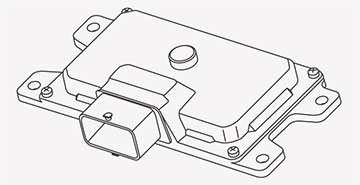
The EMCM is an ECU which controls the Engine ON Energy Management function and plays a major role in control of the Idle Stop/Start system.
CURRENT SENSOR AND TEMPERATURE SENSOR
Both the main battery and the sub-battery have a current sensor and a temperature sensor (integrated into one part) installed on the negative battery cable.
- The current sensor measures the charging or discharging rate of the battery.
- The temperature sensor uses a thermistor to measure the temperature around the battery.

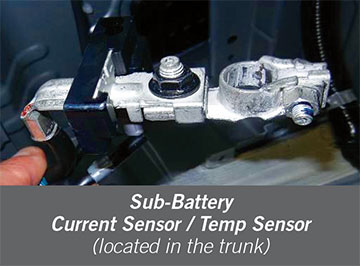
SUB BATTERY RELAY
While the engine is running, the sub battery relay is ON, connecting the main battery and sub battery, allowing generated power to flow to all systems and charge both batteries.
WHEN A START WITH THE IGNITION SWITCH OR RE-START WITH THE IDLE STOP/START SYSTEM OCCURS:
- The EMCM turns OFF the sub battery relay, disconnecting the sub-battery from the main battery..
- Only the main battery supplies power to the starter motor. The start/restart will cause a voltage drop in the main battery.
- The sub battery is isolated from the start/restart voltage drop. Full voltage is available to vehicle system connected to the sub-battery. These systems are protected from the impact of a restart (such as a memory reset) due to reduced voltage supply.
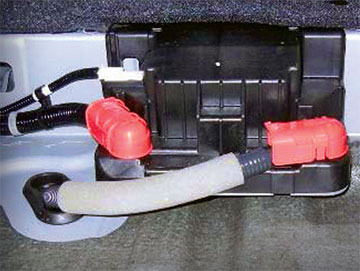
HOW THE ENGINE ON Energy Management Function WORKS
Using the main battery and sub battery current sensors, the EMCM determines if the rate of electrical discharge may overload the system and cause the battery to become discharged. The potential for this is greatest when the engine is idling with high electrical loads such as the A/C compressor engaged and/or the passengers using a lot of power (games, videos, or other electronics).
- The EMCM receives inputs from the current sensors and the battery voltage.
- The EMCM then sends a signal to the ECM.
- The ECM considers the vehicle speed signal, the door switch signal, and the A/C compressor request signal from the CAN.
- The ECM then sends a target charge voltage signal to the alternator (between 12 to 14.7 volts).
- The ECM also changes (increases) the idle speed to balance the additional mechanical load from the alternator.
- Idle speed control sets the engine’s idle speed such that the battery does not discharge during idle based on the present load.
- If either the main battery current sensor or the subbattery current sensor fails, the EMCM switches to a fixed voltage of 14.3 and the ECM does not send a voltage signal to the alternator. Then the alternator IC regulator controls the output.
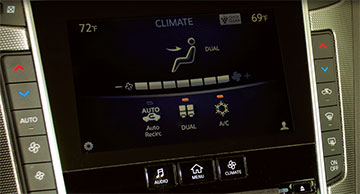
EMCM FAIL SAFE
When the EMCM determines that there is a malfunction in the Engine ON Energy Management function, the EMCM will not let the Idle Stop/Start system operate.
Also at this time, the EMCM does not send a charge voltage request signal to the ECM, and the ECM does not send a charge request to the alternator. Then the alternator IC regulator controls the output.

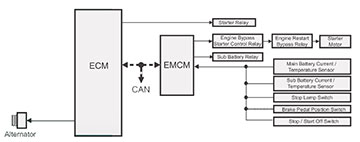
GOOD TO KNOW:
WHEN WORKING WITH THE BATTERIES IN THE Q50 2.0L, THE FOLLOWING INFORMATION IS GOOD TO KNOW:
- 12 volt batteries used in the Q50 2.0L must be speci cally designed for use with the Idle Stop/Start System.
- Before removing a 12V battery cable, turn the ignition OFF and wait at least 30 seconds.
- ECU’s may be active for several seconds after the ignition is turned OFF. If the battery cable is removed before an ECU shuts down a DTC may be stored, or ECU data corruption may occur.
- If the ignition is turned ON with any one of the cables of the main battery or the sub battery disconnected, a DTC may be stored.
- After removing/installing a 12V battery, always check “Self-Diagnosis Result” of all systems and erase any DTCs.